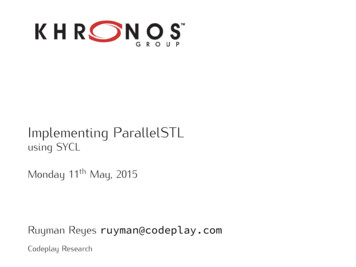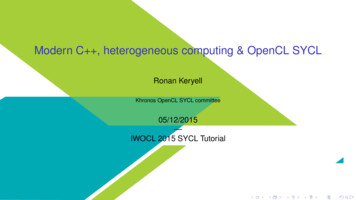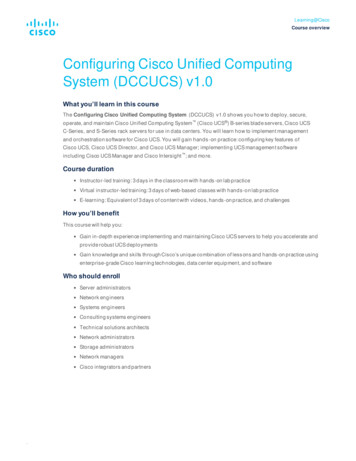
Transcription
Implementing ParallelSTLusing SYCLMonday 11th May, 2015Ruyman Reyes ruyman@codeplay.comCodeplay Research
Who am IRuyman Reyes, Ph.D# R&D Runtime Engineer, Codeplay SYCL runtime and spec. contributor.# 5 years expr. HPC BSC, EPCC among others# Research in P.M. for Heterogeneous Computing OpenMP, OMPSs, OpenAccruyman@codeplay.com@Ruyk2 / 31
Overview1 Background2 The N4409 Proposal3 A SYCL-based Parallel STL3 / 31
Background4 / 31
STL - C Standard Template Library# Widely used algorithm/container library# Template-based to enable compile-time optimizations# Any container can be used on any algorithm via iterators5 / 31
Using the STLUsing vectors, lists and algorithmsstd::vector int myVector { 8, 9, 1, 4 };std::list int myList;// Insert something at the end of the vectormyVector.push back(33);// Sort the vectorstd::sort(myVector.begin(), myVector.end());// Check that myVector is sortedif (std::is sorted(std::begin(myVector), std::end(myVector))){std::cout " Data is sorted! " endl;}// Copy elements larger than 10std::copy if(std::begin(myVector), std::end(myVector),std::back inserter(myList),[](int i){ return (i 10); });// The list should only have one elementstd::cout " List size :" myList.size() std::endl;6 / 31
Parallel libraries in Heterogeneouscomputing# Each vendor has its ownparallel-algorithm library# Interface resembles STL butdifferent# Makes code platformspecific!7 / 31
The N4409 Proposal8 / 31
Parallel STL: DemocratizingParallelism in C # Group of software engineers from Intel, Microsoft and Nvidia Based on TBB (Intel), PPL/C AMP (MS), Thrust(Nvidia)# Working draft for C 17 N4409 Previously: N3554, N3850, N3960, N4071 Describes an interface to algorithms with parallelexecution Perform parallel operations on generic containers# Extends the current STL interface with policies allowingparallel execution.9 / 31
Parallel STL: DemocratizingParallelism in C # Group of software engineers from Intel, Microsoft and Nvidia Based on TBB (Intel), PPL/C AMP (MS), Thrust(Nvidia)# Working draft for C 17 N4409 Previously: N3554, N3850, N3960, N4071 Describes an interface to algorithms with parallelexecution Perform parallel operations on generic containers# Extends the current STL interface with policies allowingparallel execution.This is still not part of the C standardThis is a work-in-progress proposal for the upcoming C 1710 / 31
Sorting with the STLA sequential sortstd::vector int data { 8, 9, 1, 4 };std::sort(data.begin(), data.end());if (std::is sorted(data)) {cout " Data is sorted! " endl;}11 / 31
Sorting with the STLA parallel sortstd::vector int data { 8, 9, 1, 4 };std::experimental::parallel::sort(par, data.begin(), data.end());if (std::is sorted(data)) {cout " Data is sorted! " endl;}# par is an Execution Policy# Both the execution policy and sort iself are defined on theexperimental::parallel namespace Will be in std:: if approved12 / 31
The Execution Policy# Enables a standard algorithm to be potentially executed inparallel Parallel execution is not guaranteed# User is responsible of providing valid parallel code.# Different libraries may have different policies13 / 31
The Execution Policy# Enables a standard algorithm to be potentially executed inparallel Parallel execution is not guaranteed# User is responsible of providing valid parallel code.# Different libraries may have different policiesWhy not just a parallel implementation?# Parallelism will not fit by default all problems# Different algorithms may be better for different platforms# Developer may want to use custom policies14 / 31
Default policiesStandard policy classes# sequential policy : Never do parallel# parallel execution policy : Do default parallelism# vector execution policy : Use vectorisation if possible# execution policy: Dynamic execution policyStandard policy objectsextern const sequential execution policy seq;extern const parallel execution policy par;extern const vector execution policy vec;15 / 31
Using policiesusing namespace std::experimental::parallel;std::vector int vec .;size t threshold 100u;execution policy exec seq;if (vec.size() threshold) {exec par;}sort(exec, vec.begin(), vec.end());16 / 31
Current implementations# The Microsoft Codeplex Parallel STLhttps://parallelstl.codeplex.com/# Thrust : Implement policies for algorithmshttps://thrust.github.io/// sort data in parallel with OpenMP by specifying// its execution policythrust::sort(thrust::omp::par, vec.begin(), vec.end());# Some other implementations from the public avail. on github. Search for Parallel STL !17 / 31
Algorithms# The proposal slightly modifies some algorithms for each does not return the Functor again# Some new algorithms are added for each n inclusive scan, exclusive scan# Many of the already defined STL algorithms shall have theExecutionPolicy overloads. copy if, copy n, remove, . . .18 / 31
A SYCL-based Parallel STL19 / 31
Codeplay SYCL STL implementation# Khronos Open Source License# Available on lSTL# Current basic implementation: Policy mechanism in place sort (bitonic if size is power of 2, seq on gpu otherwise) parallel transform parallel for eachPlenty of opportunities for your contribution!# Implement more functions# Improve algorithms# Suggestions on the interface (e.g. Device-side vector?)20 / 31
Sorting with the STLA sequential sortvector int data { 8, 9, 1, 4 };sort(data.begin(), data.end());if (is sorted(data)) {cout " Data is sorted! " endl;}21 / 31
Sorting with the STLSorting on the GPU!vector int data { 8, 9, 1, 4 };sycl::sort(sycl policy, v.begin(), v.end());if (is sorted(data)) {cout " Data is sorted! " endl;}22 / 31
Sorting with the STLSorting on the GPU!vector int data { 8, 9, 1, 4 };sycl::sort(sycl policy, v.begin(), v.end());if (is sorted(data)) {cout " Data is sorted! " endl;}# sycl policy is an Execution Policy# data is an standard stl::vector# Technically will use the device returned by default selector23 / 31
The SYCL Policytemplate typename KernelName DefaultKernelName class sycl execution policy {public:using kernelName KernelName;sycl execution policy() default;sycl execution policy(cl::sycl::queue q);cl::sycl::queue get queue() const;};# Indicates algorithm will be executed using a SYCL-device# Can optionally take a queue Re-use device-selection Asynchronous data copy-back .24 / 31
Why the KernelName template?Two separate calls can generate different kernels!transform(par, v.begin(), v.end(), [ ](int& val){ val ; });transform(par, v.begin(), v.end(), [ ](int& val){ val--; });25 / 31
Why the KernelName template?Two separate calls can generate different kernels!transform(par, v.begin(), v.end(), [ ](int& val){ val ; });transform(par, v.begin(), v.end(), [ ](int& val){ val--; });Why is this?auto f [vectorSize, &bufI, &bufO, op](cl::sycl::handler &h)mutable {.auto aI bufI.template get access access::mode::read (h);auto aO bufO.template get access access::mode::write (h);h.parallel for /* The Kernel Name */ (r,[aI, aO, op](cl::sycl::id 1 id) {aO[id.get(0)] UserFunctor(aI[id.get(0)]);});};26 / 31
Using named policies and queuesusing namespace cl::sycl;using namespace experimental::parallel::sycl;std::vector int v .;// Transformdefault selector ds;{queue q(ds);sort(sycl execution policy(q), v.begin(), v.end());sycl execution policy class myName sepn1(q);transform(sepn1, v2.begin(), v2.end(),v2.begin(), [ ](int i) { return i 1;});}# Only required for lambdas, not functors# Device selection and queue are re-used# Data is copied in/out in each call!27 / 31
Avoiding data-copies using buffersusing namespace cl::sycl;using namespace experimental::parallel::sycl;std::vector int v .;default selector h;{buffer int b(v.begin(), v.end());b.set final data(v.data());{cl::sycl::queue q(h);sort(sycl execution policy(q), begin(b), end(b));sycl execution policy sepn1(q);transform(sepn1, v2.begin(), v2.end(),v2.begin(), [ ](int i) { return i 1;});}}# Buffer is constructed from STL containers# Data will be copied back to the container when buffer isdone Note the additional copy from vec to buffer and viceversa28 / 31
Using device-only datausing namespace experimental::parallel::sycl;default selector h;{buffer int b(range 1 (size));b.set final data(v.data());{cl::sycl::queue q(h);{auto hostAcc b.get access mode::read write,target::host buffer ();for (auto & : hostAcc) {*i read data from file(.);}}sort(sycl execution policy(q), begin(b), end(b));transform(sycl policy, begin(b), end(b), begin(b),std::negate int ());}}# Data is initialized in the host using a host accessor# After host accessor is done, data is on the device29 / 31
SYCL/STL interop functionsDefined in SYCL# Buffer constructor taking begin/end# set final data taking begin/endExtended by SYCL STL# Host and Buffer iterators# begin/end functionsRemember: You need an accessor to read data from buffers!30 / 31
Final RemarksIf you have any questions or comments. . .sycl@codeplay.comruyman@codeplay.com@Ruyk31 / 31
STL - C Standard Template Library # Widely used algorithm/container library # Template-based to enable compile-time optimizations # Any container can be used on any algorithm via iterators 5/31. Using the STL Using vectors, lists and algorithms std::vector int myVector { 8, 9, 1, 4 };










